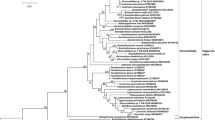Abstract
Experimental infections of Egyptian Pseudosuccinea columella with one or two miracidia of Fasciola hepatica per snail were carried out to determine the developmental pattern (normal or abnormal) of redial generations and specify the number of free rediae developing in snails according to their generation. Controls were constituted by a French population of Galba truncatula infected according to the same protocol. Most infected P. columella showed a normal development of redial generations (96.2–98.1 vs 75.5–85.7 % for G. truncatula). In each redial category, free rediae were more numerous in P. columella than in G. truncatula, and their number were also greater in the two-miracidia groups than in single-miracidium infections for each lymnaeid considered separately. This increase in redial production was mainly due to the number of first mother (R1a) rediae producing daughter rediae only: 2 per P. columella (vs one redia in G. truncatula) in single-miracidium groups and 3.1 (vs 1.9) in the two-miracidia groups. In P. columella, the mean total number of free rediae developing in single-miracidium and bimiracidial infections was 77.2 and 117.6, respectively (instead of 33.5 and 52.1 rediae in G. truncatula). The number of F. hepatica rediae present in P. columella was related to the number of fully grown sporocysts and the quantity of R1a rediae which developed into the snail body.



Similar content being viewed by others
References
Augot D, Rondelaud D, Dreyfuss G, Cabaret J, Bayssade-Dufour C, Albaret JL (1998) Characterization of Fasciola hepatica redial generations (Trematoda: Fasciolidae) by morphometry and chaetotaxy under experimental conditions. J Helminthol 72:193–198
Augot D, Abrous M, Rondelaud D, Dreyfuss G, Cabaret J (1999) Fasciola hepatica: an unusual development of redial generations in an isolate of Lymnaea truncatula. J Helminthol 73:27–30
Belfaiza M, Moncef M, Rondelaud D (2005) Fasciola hepatica: an unusual case of adaptation to a Moroccan population of Galba truncatula. Parasitol Res 95:374–378
Boray JC (1978) The potential impact of exotic Lymnaea spp. on fascioliasis in Australasia. Vet Parasitol 4:127–141
Brown DS (1994) Freshwater snails of Africa and their medical importance, 2nd edn. Taylor & Francis Ltd, London, 606 pp
Calienes AF, Fraga J, Pointier JP, Yong M, Sánchez J, Coustau C, Gutiérrez A, Théron A (2004) Detection and genetic distance of resistant populations of Pseudosuccinea columella (Mollusca: Lymnaeidae) to Fasciola hepatica (Trematoda: Digenea) using RAPD markers. Acta Trop 82:83–87
Cordeiro J, Bogan A (2012) Pseudosuccinea columella. In: IUCN Red list of threatened species, version 2013.1. URL: www.iucnredlist.org. Accessed 15 Oct 2013
Cruz-Reyes A, Malek EA (1987) Suitability of six lymnaeid snails for infection with Fasciola hepatica. Vet Parasitol 24:203–210
Dar Y, Vignoles P, Rondelaud D, Dreyfuss G (2014) The role of the lymnaeid snail Pseudosuccinea columella in the transmission of the liver fluke Fasciola hepatica in Egypt. J Helminthol
Dreyfuss G, Vignoles P, Rondelaud D (2007) Fasciola hepatica: the infectivity of cattle-origin miracidia had increased over the past years in central France. Parasitol Res 101:1157–1160
Gutiérrez A, Yong M, Perera G, Sánchez J, Théron A (2002) Fasciola hepatica (Trematoda: Digenea): its effects on the life history traits of Pseudosuccinea columella (Gasteropoda: Lymnaeidae), an uncommon interaction. Parasitol Res 88:535–539
Gutiérrez A, Pointier JP, Yong M, Sánchez J, Théron A (2003) Evidence of phenotypic differences between resistant and susceptible isolates of Pseudosuccinea columella (Gastropoda: Lymnaeidae) to Fasciola hepatica (Trematoda: Digenea) in Cuba. Parasitol Res 90:129–134
Hubendick B (1951) Recent Lymnaeidae. Their variation, morphology, taxonomy, nomenclature, and distribution. Küngl Svenska Vetenskaps Handl 3:1–223
Ollerenshaw CB (1971) Some observations on the epidemiology of fascioliasis in relation to the timing of molluscicide application in the control of the disease. Vet Rec 88:152–164
Pointier JP, Coustau C, Rondelaud D, Théron A (2007) Pseudosuccinea columella (Say 1817) (Gastropoda, Lymnaeidae), snail vector of Fasciola hepatica: first record for France in the wild. Parasitol Res 101:1389–1392
Rondelaud D, Barthe D (1987a) Fasciola hepatica L.: étude de la productivité d’un sporocyste en function de la taille de Lymnaea truncatula. Parasitol Res 74:155–160
Rondelaud D, Barthe D (1987b) Fasciola hepatica L.: étude du développement des rédies chez quatre espèces de limnées. Bull Soc Fr Parasitol 5:99–104
Rondelaud D, Fousi M, Vignoles P, Moncef M, Dreyfuss G (2007) Optimization of metacercarial production for three digenean species by the use of Petri dishes for raising lettuce-fed Galba truncatula. Parasitol Res 100:861–865
Rondelaud D, Vignoles P, Dreyfuss G (2009a) La Limnée tronquée, un mollusque d’intérêt médical et vétérinaire. Presses Universitaires de Limoges (PULIM), Limoges, 283 pp
Rondelaud D, Belfaiza M, Vignoles P, Moncef M, Dreyfuss G (2009b) The redial generations of Fasciola hepatica: a review. J Helminthol 83:245–254
Rondelaud D, Sanabria R, Vignoles P, Dreyfuss G, Romero J (2013) Fasciola hepatica: variations in redial development and cercarial production in relation to the geographic origin of the parasite. Parasite 20:33
Rondelaud D, Mouzet R, Vignoles P, Dreyfuss G, Cabaret J (2014) The production of mammalian trematode infective stages by the snail Galba truncatula. J Helminthol 88:105–111
Taraschewski H (2006) Hosts and parasites as aliens. J Helminthol 80:99–128
Vázquez AA, Sánchez J, Pointier JP, Théron A, Hurtrez-Boussès S (2014) Fasciola hepatica in Cuba: compatibility of different isolates with two intermediate snail hosts, Galba cubensis and Pseudosuccinea columella. J Helminthol. doi:10.1017/S0022149X13000382
Zischke JA (1967) Redial populations of Echinostoma revolutum developing in snails of different sizes. J Parasitol 53:1200–1204
Author information
Authors and Affiliations
Corresponding author
Rights and permissions
About this article
Cite this article
Dar, Y., Rondelaud, D., Vignoles, P. et al. Fasciola hepatica: development of redial generations in experimental infections of Pseudosuccinea columella . Parasitol Res 113, 2467–2473 (2014). https://doi.org/10.1007/s00436-014-3893-x
Received:
Accepted:
Published:
Issue Date:
DOI: https://doi.org/10.1007/s00436-014-3893-x




